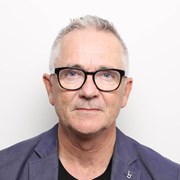The world’s first fully electric high-speed ferry has arrived! It was launched only recently in Stavanger in south-western Norway, where it will be transporting the inhabitants to and from the islands that lie north of the city. The ferry can carry 147 passengers and 20 bicycles and has a cruising speed of 23 knots.
Optimising form and function
The vessel has been built of aluminium by the company Fjellstrand as part of an EU-funded project called TrAM. The Fjellstrand yard has developed the basic layout (so-called general arrangement, Ed.) for the vessel, including its hull and passenger area, as well as the placement of the energy system, evacuation equipment and the bridge.
With this as his starting point, SINTEF researcher Einar Hareide has fine-tuned and optimised the lines plan and functional character of the vessel.
“A positive user experience is the basis for good design”, says Hareide, who was educated as an industrial engineer. “Our aim is that the passengers shall feel that they are travelling in a transport system of the future and that they are safe and comfortable – enough to encourage them to travel on the vessel again”, he says.
Creating an identity
“My task was to give the vessel a clear identity within an existing framework of basic principles”, says Hareide. “Much of this has to do with creating a holistic design with a distinctive character that will promote a positive user experience”, he says.
Engineering components such as the battery pack and electric engine form the basic constraints in the vessel construction. There are also many legislative requirements that have to be complied with – everything from sightlines from the bridge to ensuring that there is room for the passengers to travel safely and comfortably. There are many areas of technical know-how and specialist expertise involved in such a project.
“The biggest challenge in this project has always been tackling the technical limitations that were in place from the beginning”, says Hareide. “Integrating the battery pack that protrudes from the rear of the afterdeck was particularly challenging ”, he says.
Creating innovation
It is important always to be asking questions during a design process. This project involved a process in which many partners were making contributions.
“It’s all about dialogue and the maturation of ideas”, says Hareide, who combines research with his work as a designer .“After a while this often results in insights and solutions that we weren’t aware of at the start”, he says.
An industrial designer collects and balances know-how and requirements provided by a large number of different sources and assembles them into an integrated product in close collaboration with many other experts.
“The benefit of my being an outsider is that I am blind to some of the limitations recognised by the other experts in their respective fields”, says Hareide. “This enables me to challenge received wisdom and promote dialogue that can create innovation”, he says.
Module-based design
In this project, Hareide has found it important to think in terms of ‘modules’. It has to be possible for everything from the smallest components to the larger modules to be recycled and used in other vessels in the future.
“The plan is to assemble an entire fleet of fully electric high-speed ferries”, says Hareide. “For this reason, it‘s been important to take the long view and plan for all sorts of eventualities. When you’re developing new and sustainable products in this way, you’re helping towards reducing resource use and rationalising the ways in which products are manufactured”, he says.
Project partners:
The Norwegian partners in the project partners are the Rogaland County Administration, Kolumbus, the Maritime CleanTech cluster, Servogear, Wartsila, Fjellstrand, Hydro and Leirvik. SINTEF is a member of the business cluster Maritime CleanTech, which has initiated the project.


